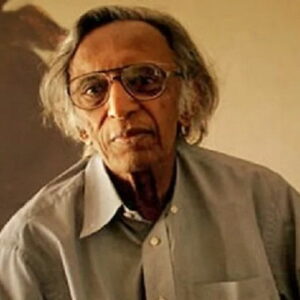It’s not every day that a man of Tyeb Mehta’s creative caliber is born. Tyeb Mehta was a very skilled Indian painter whose works exemplified Indian art’s current language. He is regarded as a cultural hero who, via his paintings, exposed the ills of modern society, most notably their misery, agony, and perplexity. Events and experiences from his personal life affected much of his creative career, as he was born at a period when nationalism was at its pinnacle in the country. On his canvas, he depicted the spirit of nationalism as well as the sadness that came with division. Later, he was influenced by New York’s minimalist art and Francis Bacon’s expressionist paintings. Tyeb Mehta became India’s most famous artist after being the first Indian modern artist whose work sold for more than a million dollars. He also sparked what would later become the country’s great Indian art boom.
Childhood and Adolescence
Tyeb Mehta was born on September 26, 1925, into a Shi’ite Muslim household in Kapadvanj, Gujarat’s Kheda district. His family opted to remain in India rather than go to Muslim-dominated Pakistan at the country’s division.
Tyeb was raised in Mumbai’s Crawford Market neighborhood, where he was heavily inspired by the communal disturbances to which his family was subjected during partition. Early in his youth, he experienced events that had a significant impact on his upbringing and subsequent profession.
Career of Tyeb Mehta
Along with his family, he began his profession as a film editor at Famous Studios in Tardeo, Mumbai, in a cinema laboratory. His passion for painting led him to the Sir J.J. School of Art in 1952, where he received his certificate in painting.
Later, he became a member of the Bombay Progressive Artists Group, which had the likes of FN Souza, SH Raza, and MF Husain among its members. He shaped his paintings along the same lines as the group’s western modernism.
He relocated to London in 1959, where he spent the formative years of his adolescence. During this period, he was influenced by the work of Francis Bacon, an expressionist painter with whom he had become acquainted in London. His future paintings were heavily influenced by the latter’s work.
He went to New York in 1964, and in 1968, he received a scholarship from the John D Rockefeller 3rd Fund. As he took influence from minimalist art, his painting style changed, and his work became known for its simplicity. When he returned to India, he settled in Mumbai. In 1970, he created a three-minute film called ‘Koodal,’ which means’meeting place’ in Tamil. The film, which was largely shot in the Bandra slaughterhouse, earned him his first Filmfare Critics Award.
During this period, he created the well-known image of a trussed bull, which depicted the light of helpless animals in the Mumbai slaughterhouse. He was the Artist-in-Residence at Santiniketan for a year, from 1984 to 1985. Significant developments in his work and painting topics occurred during this time.
He created the painting ‘Falling Figure’ in 1991, which was heavily influenced by the community disturbances he saw as a youngster. He brought to the fore the brutal killing of a guy on the street, which he observed during the Partition of India riots. The picture depicted the man’s extreme suffering and savagery.
During this time, he created a number of significant pieces, including one depicting an imprisoned rickshaw puller, which reflected his pessimism about the world, and others. His picture of the monster MahisHasura and Goddess Kali was the most well-known at the period, bringing him great fame and acclaim. He received a lot of praise for the way he handled the topic on canvas. Furthermore, in 2005, the artwork sold for 10 million Indian rupees at Saffornart’s online auction.
In the same year, he made history when his painting ‘Gesture’ was sold at the Osian’s auction for 31 million Indian rupees to Ranjit Malkani. He became the highest-paid Indian modern artist at an auction as a result of the deal. He was also the first Indian artist to get such a large sum of money from an Indian customer.
Achievements & Awards
In 1974, during the International Festival of Painting in Cagnes-sur-Mer, France, he was awarded the Prix Nationale.
The Kalidas Samman was bestowed upon him by the Madhya Pradesh government in 1988. Padma Bhushan, India’s third highest civilian award, was bestowed upon him by the Indian government in 2007.
Personal History and Legacy
Sakina was the woman he married. Yusuf, the couple’s son, and Himani, the couple’s daughter, were born to them.
He died of a heart attack on July 2, 2009.
Estimated Net Worth
The estimated net worth of Tyeb Mehta is $8 Miilion
Trivia
Mehta, a very self-critical painter, had established such high standards for himself that for every picture he sold at an auction, he destroyed seven to eight others until he found the one that fit his criteria.


